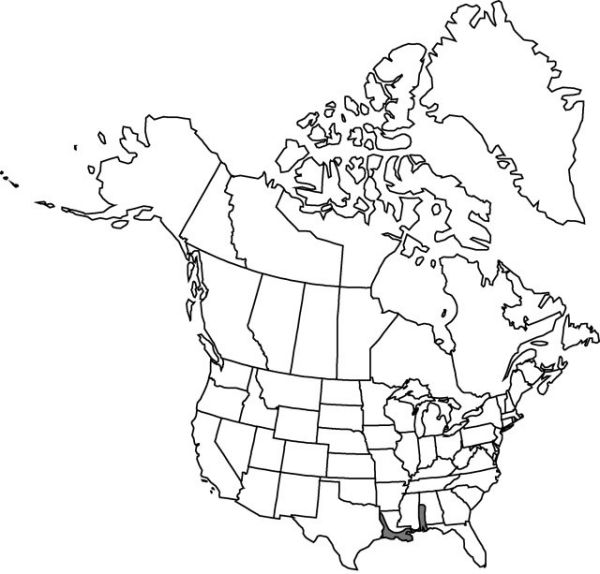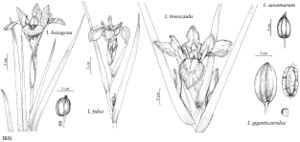Iris giganticaerulea
Addisonia 14: 5, plate 451. 1929.
Rhizomes green, extensively branched, forming large clumps, 2–4 cm diam., with pale leaf scars. Stems 2–3-branched, solid, 10–15(–20+) dm. Leaves: basal 4–6, erect, blade bright green, ensiform, 10–13 dm × 2–3 cm, apex slightly curved; cauline with blade foliaceous, appearing as elongated spathe, 5–6.5 dm × 2–3 cm, not exceeding flowers. Inflorescence units 2–3-flowered, branch units 1–2-flowered; spathes tightly enclosing ovary and pedicel, 15–20 cm, subequal; outer narrowly lanceolate, keeled, margins pale, narrow, inner margins translucent, broad, scarious. Flowers: perianth blue or blue-purple; floral tube tubular-prismatic, 9-ribbed and -grooved, 4–5 cm; sepals blue or blue-purple with white streaks surrounding signal, oval to orbicular-oval, 9.5–11 × 4–5 cm, base abruptly attenuate into claw, apex obtusely angled, signal with raised, yellow, pubescent central ridge, claw green, striate, 4–4.5 × 1–1.2 cm; petals erect or spreading-erect, spatulate, 7–8.5 × 2–3 cm, base cuneate, apex emarginate; ovary bluntly 6-angled, 4–4.5 cm; style blue-violet, keeled, 3.5–4 cm, raised above sepals, crests recurved, 1.5–2 cm, margins sharply and irregularly serrate; stigmas 2-lobed with 2 triangular teeth; pedicel columnar, 3.5–5 cm. Capsules drooping, bright green, ellipsoid, hexagonal in cross section, with 6 broad, rounded lobes, 8–10 × 3 cm, indehiscent; after anthesis, flower stem elongates, arching downward to push capsule into water, where walls are broken down and as funiculus is broken, seed rises to surface. Seeds in 2 rows per locule, brown, D-shaped, 8–10 mm wide, very corky. 2n = 44.
Phenology: Flowering Mar–Apr.
Habitat: Shallow water or very wet roadside ditches
Distribution

Ala., La., Miss.
Discussion
Selected References
None.
